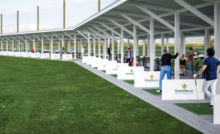Exploring new ground 2015 US Open at Chambers Bay Golf Course in University Place (Feb 20)
February 20, 2015 – The 2015 United States Open Championship will be a unique one in a number of ways. For the first time, the Open will be conducted in the Pacific Northwest at Chambers Bay Golf Course in University Place, Wash., along the shores of Puget Sound.
The fairways, tees and greens at Chambers Bay are all comprised of fescue, which excites United States Golf Association executive director Mike Davis.
“It’s never been done before,” he says. “Never been done certainly in the United States. And if you think about playing on fine fescue putting greens, that’s not even done in the Open Championship across the pond in the UK. So we’re excited about that.”
Chambers Bay is a municipal facility, owned and operated by Pierce County. It opened for play in 2007 and hosted the U.S. Amateur Championship just three years later.
Architect Bruce Charlton, the lead designer for Robert Trent Jones Jr., says the course was created with championship play in mind.
“We put the golf course that we were building on the USGA radar screen early, early on,” he says. “As early as 2003, 2004, when we got the job. I was at a Christmas party at Mr. Jones’ house and I spoke to Ron Read who was the USGA representative for our section of the United States and I said, ’We’ve got a project here you have to keep your eyes on because it could be something special.’”
Charlton says the course was built to accommodate a large-scale USGA event like an Open. He notes the organization offered input during the construction process.
“They came out during construction and looked at things,” Charlton says. “They invited us to go to their tournaments and go measure things. We started measuring how much space it took to have the corporate tents. How long they were. How wide the paths were to get people through. The amount of gallery space. What kind of horizontal and vertical dimensions does it take to have a grandstand that holds 8,000 people?”
Because fescue covers the entire playing area, there is little demarcation between fairways and tees, a circumstance that creates an abundance of course setup options.
“The fairway become the tee and the tee becomes the fairway,” Charlton says. “On a number of holes, we didn’t have tremendous elevation change. We just kept fairway grass coming right up on the tee, kind of ribbons of fairway. A lot of tees are flat; they meander around, so you can literally get on the fairway mower and just come right in and mow the tee and come right back out.”
Chambers Bay has the look of a Scottish links course. A visitor could easily imagine themselves overlooking the Firth of Clyde as opposed to Puget Sound.
The layout features exceptionally wide fairways, a delight to recreational golfers that Charlton says will encourage the players in the Open field to think twice about their strategic decisions.
“If you give the average golfer a lot of room to hit the ball and it’s fairway, they’re going to be pretty happy with the golf course,” he says, “even if the fairway does all kinds of crazy things. The best players in the world on that same tee think about the golf course they play. They stand on a lot of golf courses and they’ve got the left side clearly defined the right side clearly defined, they know exactly what the distances are to the bunkers.
“You put them on a golf course that’s got width and things are kind of random. They can hit the ball anywhere a hundred yards wide. They stop and they go, ’I don’t know where to hit this. You haven’t defined where my shot should come from.’ The key thing is we played around with distances and angles coupled with width they have to stop and think every time on the tee.”
Apart from the fescue, visitors and television viewers will see plenty of sand at Chambers Bay, and we’re not talking about bunkers. The course was built atop what was once a sand and gravel pit that for more than three decades was the source for material that was used on golf-course construction projects throughout the Pacific Northwest.
That gave Charlton an idea. “Why not let the sand be a huge component of the golf course and let people play out of it?” he says. “Instead of having fescue grasses everywhere outside of the turf, a lot of it is sand. We brought it close to play. We took it away from play. You can go in there and ground your club.”
Chambers Bay is part of a 930-acre site dedicated to recreational use. Pierce County executive Patrice McCarthy says there are plenty of amenities for non-golfers.
“We have a trail system that circumnavigates the golf course,” she says. “So even if you’re not a golfer, one of the people looking at this as an investment; they can still access that course in a public way and that’s the beauty of this golf course. It’s really a great amenity for our county folks, people that are active golfers and then people that just love the outdoors.”
Original: http://www.statewideturfequipment.com/exploring-new-ground/#sthash.DojLFfwS.dpuf
Recent Posts
Memphis Country Club: A Golfer’s Study in Precision and Tradition
If you have ever teed it up at Memphis Country Club, you know this isn’t…
Foley Company attains GCSAA Silver Partner Status
Foley Company, a leader in turf equipment innovation and technology, affirms its support of the…
Harrell’s continues longstanding support of the GCSAA Foundation
Harrell’s LLC, a leading distributor of customized agronomic products for turfgrass since 1941, has donated…
City of Orlando Announces New State-of-the-Art Driving Range at Dubsdread Golf Course
The City of Orlando is excited to announce the construction of a brand-new, state-of-the-art driving…
Discover Puerto Rico for Great Golf Trips and After-Round Activities, Amenities
Golfers cannot live by the game alone which is why Puerto Rico provides the perfect…
Q&A with a Multi-talented Golf Course Architect – Part 2: Making the Rounds – Installment 39
This column features recollections of the author’s 37 years as a golf writer. These installments…



